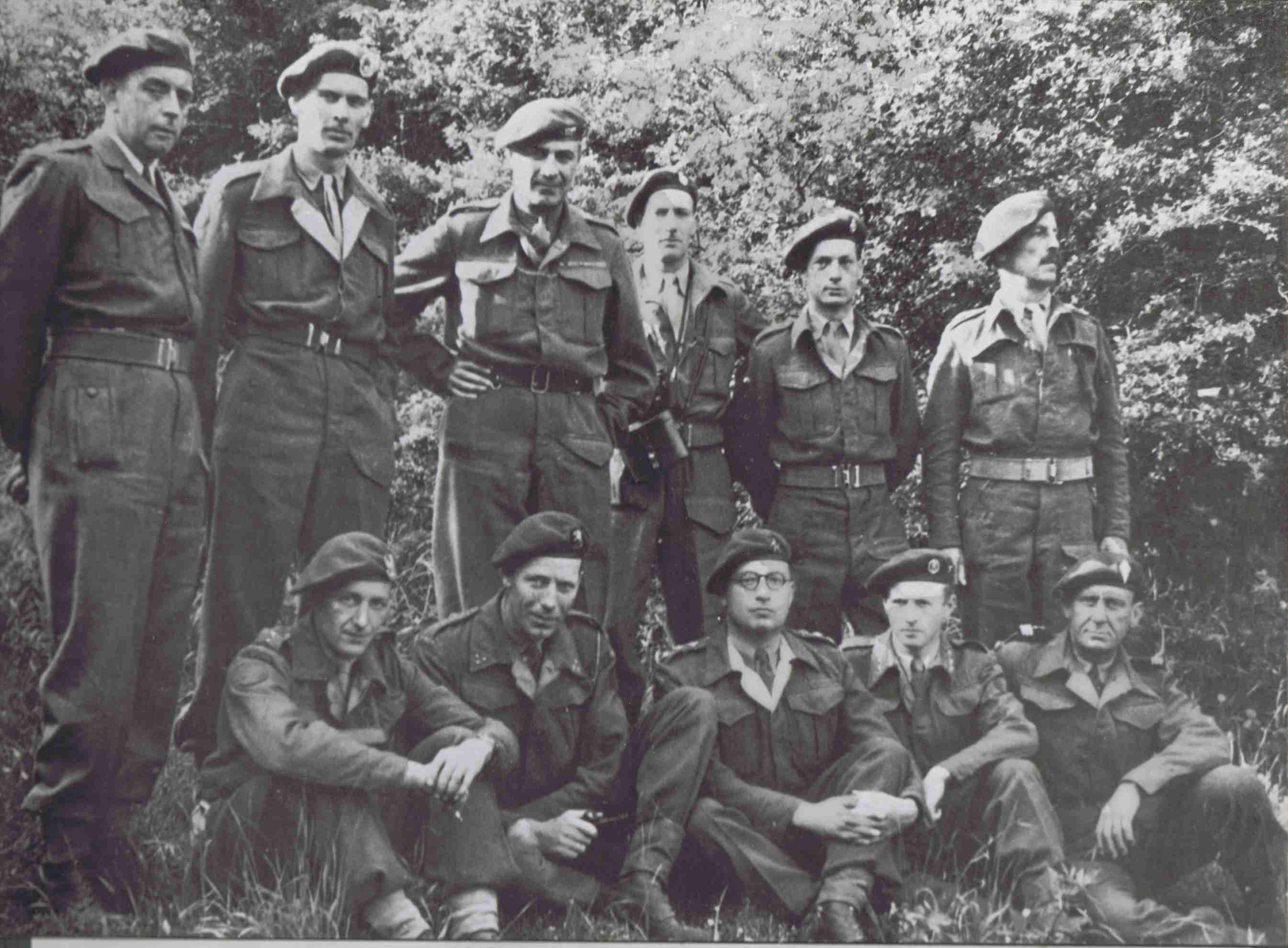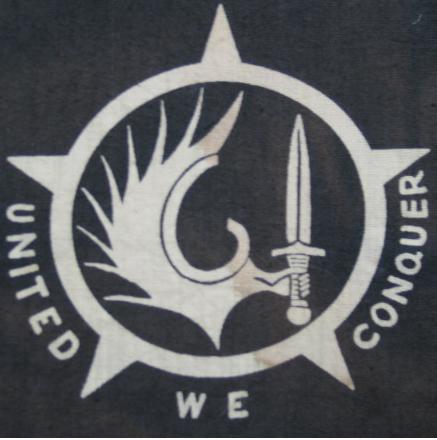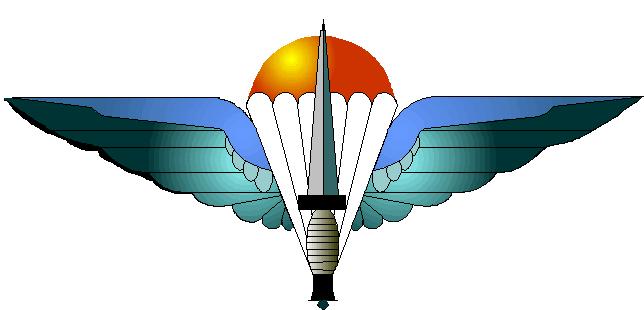09. Former and current "COMMANDO" units.
N°10 Inter-Allied COMMANDO
The N°10 IA Commando was raised in spring 1942, it was formed with Troops (about a hundred men) from different nationalities and each Troop had its number.
The first Troop was French and was the first to be raised, in Lay 1942, under command of Major KIEFFER. It was formed with seamen.
Than, the 2nd Troop, Dutch, was under command of Captain MULDERS.
The 3rd Troop, also called “X-Troop” was under command of Captain Bryan HILTON JONES (UK) and was composed of Germans and Austrians (nearly all being Jewish) as well as Hungarians, Romanians or Czechoslovakians, all German speaking. None of them had any illusion about his lot if caught by the Germans. The X-Troop was not used as a full combat unit. Small teams went with the other Troops in combat missions and where serving as interpreter to question the prisoners, read and translating the documents, etc…
4th Troop was a Belgian one, under commando of Captain G. DANLOY.
The 5th Troop was Norwegian, under command of Captain HAUGE.
The 6th Troop was Polish and its OC was Captain SMROKOWSKI.
There was a Yugoslavian one, the 7th Troop.
The 8th Troop was also a French one, it was only raised in May 1943 and was under command of Lt TREPEL who had been as far as there, 2ic of Commandant KIEFFER.
Standing, from left to right.
Captain E.F. LUTYENS (LO BE Troop) – Captain CLARCKE (Adjutant (S1)) – Lt-Col Dudley LISTER (CO 10 IA) – Major P. LAYCOCK (2ic) – Captain Bryan HILTON JONES (OC X-Troop) – Captain HODGES (MO).
Sitting, from left to right.
Lieutenant WOLOSZOWSKI (2ic PO Troop) – Captain MULDERS (OC NL Troop) – Captain G. DANLOY (OC BE Troop) – Captain HAUGE (OC NO Troop) – Commandant (major) P. KIEFFER (OC FR Troop).
4ème Troop of N°10 Inter-Allied COMMANDO
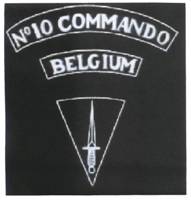
On July 27th, 1942, a Belgian "Troop" (N° 4) is created within the 10th Interallied Commando in Great Britain. Seven Officers and a hundred Volunteers recruited among the units of the Belgian Forces in Great Britain undergo a tough training at the "Commando Basic Training Center" of Achnacarry in Scotland. There, the "4th Troop" under the command of Captain George Danloy will get the green beret.
At the end of this training, the Belgian "Troop" settles in Abersoch in the north of Wales to continue its training there. It will also stay in Portsmouth and Plymouth (amphibious training) and in St Ives (cliff attacks).
In September 1943, the "4th Troop" departs to North Africa (in the area of Algiers) and integrates the 2d Commando Brigade.
On Monday December 13th, 1943 at 1 p.m., the "4th Troop" is the first Belgian terrestrial unit to fight again (after the defeat of 40). Initially, within the VIII Army, it is engaged in the front of the Sangro river in Italy to carry out patrols and raids, in particular in the mountainous sectors of San Pietro Avellana and Montenero. Then, in January 44, the Unit is engaged in the front of the Vth Army and takes part in the crossing of the Garigliano and in the seizure of Minturno and Monte Ornito.
In March 1944, the "4th Troop" is in Yugoslavia on the island of Vis where it takes part in the defence of the island, in the harassing of the enemy on the neighbouring islands and in attacks with boarding on enemy supply ships.
The Unit then departs to Great Britain from where in August 44, a Section carries out a reconnaissance raid on the island of Yeu off Saint Nazaire. Back to Belgium in October, the "4th Troop" takes part, as from November 1st, in the first wave of assault to conquer the island of Walcheren that is liberated after violent fightings.
In January 1945, the troop is reinforced by 250 new Belgian Commandos, recruited in Belgium in autumn 44 and who come from Achnacarry.
In April 45, the Troop that has become an "Independent Unit Commando" joins the "1st Commando Brigade" in the north of Germany and finishes the war on the coast of the Baltic. In may 45, it is charged with a safety mission in Schleswig-Holstein: to hunt the Nazis and to capture the Belgians who have worn the Nazi uniform. Among others, it will take prisoner Major PSC HELLEBAUT, commanding the "Wallonia Legion".
On May 15th, 1945, the "Independent Commando Unit" takes the title of "Commando Regiment ".
Trilingual, the "4th Troop" was made up of French-speaking, Dutch-speaking and English-speaking Belgians coming from Anglo-Saxon countries. The common language within the "N° 10 Inter-Allied Commando" was the English.
-------------------------------------------------------------------------------------------------------------------------------
2nd COMMANDO Battalion (2 Co Bn)

In September 1945, the "Commando regiment" returns to Belgium and settles in Marche-les-Dames and Namur and, later, also in Seilles.
The Decree of the Regent N° 2837 of August 26th, 1946 assigns a Standard to the regiment and, on October 22nd of the same year, during a ceremony in the Palace of Brussels, Lieutenant-colonel G. Danloy receives the Standard from the Prince regent. On April 1st, 1951, the "Commando regiment" changes name and bears the name of "Commando Battalion". During a few months, it will be even called "1st Commando Battalion". In 1955, the unit takes the name of 2nd Commando Battalion.
As from 1953, the Commandos take an active part in the "African period": they give instruction to many detachments intended for the Kamina Base (BAKA) in Belgian Congo. At that time, the Battalion consists of two fusiliers companies (1st and 2nd Company) and of a Staff and Services company (E.M.S.).
Following the riots of January 59, it is sent with the utmost urgency to Léopoldville where its stays approximately one month. It is the first time that a Belgian unit is sent abroad without pre-alarm. Awaked in the night of January 10th, the Commandos fly at the end of the afternoon towards Belgian Congo on board of a SABENA plane. A part of the officers and the militiamen then form the 4th Commando Battalion which settles in Kitona in Low-Congo.
In February 1960, the 2nd Commando Battalion moves to Kamina, (the militiamen have three months of service), remains there two months to resume its instruction and to obtain the A para brevet (brevet for the first Battalion without jump refusal), and then settles in the Kitona base (BAKI). Once more, part of the officers and the militiamen remains in Kitona and forms a new battalion, the 6th Commando Battalion.
Until February 62, the 2d Commando Battalion forms and sends officers and militiamen to the 4th Commando battalion stationed in Ruanda.
After the
"African period", the 2d Commando battalion is
organised in three fusiliers’ companies (12th, 14th and 16th company) and a
staff and services company. From 16 to 30 November 1964, a fraction of the
Staff and the 12th company take part with the 1st Para Battalion to
the humanitarian operation in Stanleyville and Paulis in Congo. The detachment
is mentioned in dispatches:
…The 12th Company of the 2d Commando Battalion.
« From 24 to 27 November 1964, to have behaved with much coolness, energy and discipline in order to achieve a tricky and dangerous mission of liberation of Belgian and foreign civilians kept as hostages in Stanleyville and Paulis »
From June to August 1974, a detachment (30 men) carries out a humanitarian mission to the benefit of the starving populations of the Sahel.
In 1978, the 14th Company and the 4"2 mortar platoon (216 men) take part in the humanitarian operation in Shaba (Kolwezi)"Red Bean" within the Para-Cdo Regiment.
The detachment is mentioned in dispatches:
KOLWEZI
... the Para-commando Anti-tank Company.
... the 14th Company and the Mortar platoon of the 2d Commando Battalion "
From 19 May to 10 July 1978, to have shown coolness and remarkable discipline and effectiveness in the achievement of a mission of liberation and protection of Belgians and Foreigners whose life was threatened,
in Shaba and more particularly in Kolwezi"
The following year, alarmed by information about a possible recurrence of the Kolwezi events, the 2d Commando Battalion is commissioned to teach the Zairean Armed Forces and act as dissuasion force in Low-Zaire "Green APPLE".
The Battalion joins the Kitona base as from February 12 and remains there until March 30.
In 1985, the Battalion, in reinforcement of the police force, carries out safety patrols to protect the Belgian population against the terrorist attacks of the Cellules Communistes Combattantes (C.C.C.).
On 4 October 1990, operation "Green Bean". The Battalion reinforced with a company of the 3d Para Battalion and a platoon of the Para-Commando Recce Squadron is sent to Kigali in Rwanda.
Mission: to control the aerodrome to prevent the Tutsi rebels to seize it and, if necessary, allow the evacuation of Belgian and German nationals. The mission ends on 31 October.
September 1991, operation "Blue Beam" in Zaire. The Para-Cdo Regiment is sent to protect the evacuation from of Belgian nationals. On 27 October, the 16th Company is sent to Libreville in Gabon in intervention reserve.
In April 1993, the 2d Commando battalion relieves in Somalia the 1st Parachutist Battalion within the framework of the mission "Restore Hope", mission named "UNOSOM" and FALLS UNDER THE CONTROL OF THE UNITED NATIONS on May 4, 1993. The Battalion and the Para-Commando Artillery Battery are the first Units of the Para-Cdo Brigade to wear the blue beret of the United Nations. They settle in Kismayo.
In March 1994, the Battalion relieves in Rwanda the 1st Para Battalion within the framework of mission "UNAMIR", once more under the control of the U.N. On April 6, the President of Rwanda is assassinated. That results in massacres without precedent in the country. On April 7, Mrs Agathe Uwilingiyimana, Prime Minister of Rwanda is assassinated, with her children, by soldiers of the Presidential Guard. A Section of the Mortar platoon, in charge of her protection, tried in vain to protect the escape of the Prime Minister. Arrested by Rwandan soldiers, superiors in numbers, the Section is led to a camp of the Rwandan Army where it will be savagely slaughtered.
Ten Commandos will lose their life:
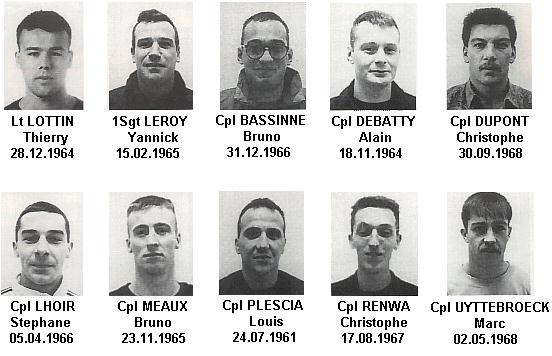
On April 19, the Belgian Government decides to withdraw the Belgian Commandos from mission "UNAMIR" and there follows the operation "Blue Safari": 16 C-130 sorties of the 15th Wing of transport of the Belgian Air Force allow the 2d Commando battalion to get out of Kigali in less than 5 hours.
In 1999, as from April 17, the Battalion flies to Albania where it takes part in the humanitarian operation "Allied Harbour" to escort and protect the convoys of Kosovar refugees between Kukës and Mjede. After a short stay in Kosovo, the Battalion returns to Belgium as from July 17.
Since 1966, the 2d Commando Battalion takes regularly part in manœuvres in Denmark, Greece, Italy and Turkey within the AMF (L), just like the other Units of the Para-Commando Brigade:
Quarters.
Back in Belgium in September 1945, the Commando regiment settles in Marche-les-Dames. In December, the first militiamen are incorporated in the citadel Terre-Neuve of Namur.
With an increased strength, the Commando regiment is established in three quarters: Marche-les-Dames, Citadel of Namur and Seilles.
In 1952, the Battalion occupies the Barracks of Seilles with two companies (1st and 2nd), the castle of Marche-les-Dames with the Staff and the 3rd company in the camp of Wartet.
In 1955, the Battalion which has no more than two fusiliers’ companies and a staff company, settles in the citadel of Namur and remains there until 1961, when it will move to the Barracks Slt Thibaut in Flawinne and stay there until now.
Traditions.
The 2d Commando Battalion is the direct heir of the traditions of the "4th Troop of N° 10 Inter-Allied Commando". It wears the green beret with an insignia created in 1950 by the chaplain of that time, Padre DEVOS. Its motto is "United We Conquer". The colours of the Unit are black and white. The personnel wears black escutcheons with white piping (old dress), the dagger on the shoulder straps. The inscription "COMMANDO" on the top of each sleeve, the "A" Commando brevet on the right sleeve and the "A" Parachutist brevet above the right pocket.
The Battalion, bilingual since its creation, unfortunately became monolingual in 1982 (French-speaking).
On January 1st, 1995, the name of the Battalion changes again:
the "2d Commando Battalion" becomes the “2d Battalion of Commandos".
Since June 4, 1972, the Battalion is sponsored by the municipality of Han-on-Lesse in the entity of Rochefort.
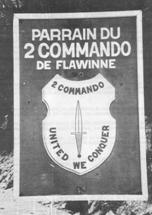
|
|
Corps commanders.. |
|
|
|
|
|
|
Lieutenant-Colonel |
G. Danloy |
1942-1952 |
|
Lieutenant-Colonel |
A. Renard |
1952-1958 |
|
Major |
P. Lemercier |
1958-1959 |
|
Major |
O. Janssens |
1959-1961 |
|
Major |
P. Lemercier |
1961-1962 |
|
Major |
A. Lemasson |
1962-1963 |
|
Major PSC |
J. Rousseaux |
1963-1967 |
|
Major |
A. Bruggeman |
1967-1969 |
|
Lieutenant-Colonel |
A. Meunier |
1969-1973 |
|
Lieutenant-Colonel PSC |
R. Lardin |
1973-1975 |
|
Lieutenant-Colonel |
J. Celis |
Fév-Avr 1975 (Died) |
|
Lieutenant-Colonel PSC |
H. de Maere d’Aertrycke |
1975-1978 |
|
Lieutenant-Colonel PSC |
R. De Clerck |
1978-1980 |
|
Lieutenant-Colonel PSC |
L. Henrot |
1980-1982 |
|
Lieutenant-Colonel PSC |
J. Jeunehomme |
1982-1985 |
|
Lieutenant-Colonel PSC |
A. Desmet |
1985-1987 |
|
Colonel Ir PSC |
C. Buze |
1987-1990 |
|
Lieutenant-Colonel |
F. Van de Weghe |
1990-1993 |
|
Lieutenant-Colonel PSC |
J. Dewez |
1993-1995 |
|
Lieutenant-Colonel PSC |
D. Adam |
1995-1998 |
|
Lieutenant-Colonel |
Ph. Lattaque |
1998-2001 |
|
Lieutenant-Colonel PSC |
A. Maes |
2001-2003 |
|
Lieutenant-Colonel PSC |
P. Laureys |
2003-2006 |
|
Lieutenant-Colonel PSC |
L. Hanset |
2006-2007 |
| Lieutenant-Colonel PSC | C. Closset | 2007-2010 |
| Colonel PSC | J-M Vermeulen | 2010-2013 |
| Lieutenant-Colonel PSC | V. Pierard | 2013-2015 |
| Lieutenant-Colonel Ir PSC | F. Linotte | 2015-2018 |
| Lieutenant-Colonel Ir PSC | T. Landas | 2018-2020 |
| Lieutenant-Colonel PSC | C. Van der Vorst | 2020-2022 |
| Lieutenant-Colonel PSC | J.C. Fefawes | 2022 |
|
|
Corps Warrant officers. |
|
|
|
|
|
|
Warrant officer |
J. Jonckers |
1945-1948 |
|
Warrant officer |
A Jamin |
1948-1959 |
|
Warrant officer |
L. Dewilde |
1959-1972 |
|
Chief Warrant officer |
G. Helderweirt |
1972-1980 |
|
Chief Warrant officer |
T. Van Mol |
1980-1981 |
|
Chief Warrant officer |
J. Leysen |
1981-1993 |
|
Chief Warrant officer |
P. Martinus |
1993-2003 |
|
Chief Warrant officer |
C. Fievet | 2003-2011 |
|
Warrant officer-Major |
H. Lamotte |
2011-2019 |
|
Chief Warrant officer |
D. Colige |
2019 |
|
|
Corps corporals. |
|
|
|
|
|
|
1st Chief corporal |
J. Mayeur |
1995-1997 |
|
1st Chief corporal |
Ph. Lambrette |
1997-1999 |
| 1st Chief corporal | J-C. Verschaeren | 1999-2010 |
|
1st Chief corporal |
A. Masson |
2010-2018 |
|
1st Chief corporal |
L. Raison |
2018- |
-------------------------------------------------------------------------------------------------------------------------------
4th Commando battalion ( 4 Cdo Bn)

The 4 Cdo Bn (bilingual) is set up on April 2, 1959 with the militiamen and a part of the officers of the 2 Cdo Bn having gone to the Belgian Congo as from January 10 after the riots in Léopoldville.
The Battalion settles in the base of Kitona (BAKI) and, from then on, maintains a permanent presence of "Metropolitan Forces" in Low Congo.
In April 1960, after more than one year of presence in Baki, the 4 Commando Battalion leaves Congo to settle in Ruanda.
It intervenes many times to calm things down and to avoid bloody confrontations between Batutsis and Bahutus.
In July 1960, the heavy weapons platoons of the Staff and Services company intervene twice from Kisenyi to give assistance to the population of Goma and to seize the aerodrome. The 1st Co carries out a parachute operation on Bunia. Afterwards, one of its platoons goes to Mongbwalu to release two columns of European refugees.
Three Commandos will be mortally wounded in ambushes by the police force: HOSSELET - DELAHAUT - SOSNOWSKI.
In January 1961, the 1st company based in Kisenyi repels an attack of the Congolese National army (ANC) coming from Goma.
The Commando RENARD captured during a night patrol is assassinated by the ANC.
The 4 Commando Battalion will continue its mission of maintenance of law and order in Ruanda until the independence of the country on July 1, 1962.
Its personnel will be repatriated in the current of July and the Battalion officially dissolved on October 1, 1962.
At the beginning of the Seventies, the 4 Commando Battalion becomes a reserve Para-Commando battalion with reservists of the other Battalions trained by the personnel of the Cdo TC. It is made up of the 23rd, 24th and 25th companies and of a staff and services company.
Recalls were made by this Battalion in 1974, 77, 83 and 86.
Traditions.
The Royal decree No 7397 of October 23, 1959 grants a Standard to the 4 Cdo Bn. The emblem is given solemnly by His Majesty King Baudouin to Major V Bruneau on April 1, 1960 on the esplanade of the Cinquantenaire in Brussels.
After its dissolution, the Battalion gives its Standard to the Royal Museum of the Army. It is entrusted to the Cdo TC on April 20, 1976.
Thus the 4 Cdo Bn, reserve unit, took up the traditions of the 4 Cdo Bn, active unit.
Quarters.
Initially stationed in BAKI in 1959, then in RUANDA, the Staff and Services company in KIGALI, the 1st Co in ASTRIDA and then in KISENYI, the 2nd Co in CHANGUGU.
|
|
Corps Commanders (in Africa) |
|
|
|
|
|
|
Major |
P. Lemercier |
April – July 1959 |
|
Major |
O. Janssens |
July – November 1959 |
|
Major |
V. Bruneau |
November 1959 – August 1960 |
|
Commandant |
A. Lemasson |
August– October 1960 |
|
Commandant |
J. Vaes (a.i.) |
October 1960 – January 1961 |
|
Major |
P. Lemercier |
January – July 1961 |
|
Major |
O. Janssens |
July 1961 – February 1962 |
|
Major |
V. Bruneau |
February – October 1962 |
|
|
Corps warrant officers. |
|
|
|
|
|
|
Warrant officer |
B. Schils |
1959 –1961 |
|
1 Sergeant-Major |
M. Leiding |
1961 – 1962 |
-------------------------------------------------------------------------------------------------------------------------------
6th Commando battalion (6 Cdo Bn)
The 6 Commando Battalion (bilingual) is made up on May 16, 1960 with the militiamen and a part of the officers of the 2 Cdo Bn having gone to the Belgian Congo in February.
After having gained the Para brevet in Kamina, the Battalion settles at the base of Kitona in place of the 4th Cdo Bn which heads towards Ruanda.
On 30 June, the 2nd company is sent to the Stanley base in Léopoldville. It will intervene in particular on July 8 to save the Chief of the Police force, Lieutenant-General E Janssens, and on July 12, it will seize the aerodrome of Ndjili.
In the meantime, the Battalion in Kitona seizes Boma on July 11, and organises and escorts columns of refugees to Kitona.
On 14 July in the morning, the 1st company (+) neutralises the naval base of Banane. In the afternoon, the whole Battalion is gathered on the aerodrome of Ndjili.
On July 16, the Battalion seizes Coquilhatville.
On July 17, the 2nd company (+) seizes Boende.
On July 31, the Battalion is gathered in Baki.
In August 1960, it heads towards Usumbura.
On December 24, the Recce platoon convoys a detachment of the ANC which will try, departing from Ruanda, to reconquer Bukavu occupied by rebels. The Recce platoon comes under enemy fire and withdraws, having the order not to intervene.
On December 31, 1960, the 6th Commando Battalion is dissolved.
Traditions :
The 6th Commando Battalion had taken up the Commando traditions, the green beret with the insignia of the 2d Cdo Bn. Actually, the personnel had simply kept the uniform it had on its arrival in our colony.
An unofficial insignia had been created, based on the insignia of a French Para regiment but by looking at the back face of it to reveal number 6.
|
|
Corps commanders. |
|
|
|
|
|
|
Commandant |
A. Lemasson |
May – August 1960 |
|
Major |
P. Lemercier |
August – December 1960 |
|
|
Corps warrant officers. |
|
|
|
|
|
|
Warrant officer |
H. Pellens |
May-December 1960 |
-------------------------------------------------------------------------------------------------------------------------------
Commando Training Center de COMMANDO (Cdo TC)

The first Belgian Commandos, ordered by Captain G Danloy had their Commando training in August/September 1942 in the "Commando Basic Training Center" in Achnacarry in Scotland.
At the end of war 40-45, the Belgian Commandos went into their quarters in Germany in the area of Lübeck. Some Volunteers came to join the Commando unit in Germany and settled their commando camp at the edge of the Baltic sea in Schleswig-Holstein. It is in the end of this camp that the first post-war "A" commando brevets were given.
On September 12, 1945, the Commando Unit leaves Germany to settle in Marche-les-Dames. The first incorporated voluntary militiamen in December 1945 joined at that time the Commandos in the citadel of Namur. Second lieutenants de Heusch and Liénard were charged to organise a commando camp in Marche-les-Dames of which the surroundings are appropriate for the criteria of this particular training: rocks, stretches of smooth water, wooded and hilly area. Obstacle tracks are created and, in particular, the tracks "Stamina" and "Do or Die" of Achnacarry are reconstituted. They are helped by German prisoners provided by the Command of the Province of Namur and paid for that job.
The Commando camp of Marche-les-Dames welcomes the first militiamen on February 16, 1946.
The command of the camp is entrusted at that time to Second lieutenant P. Beauprez.
On October 20, 1947, the Commando Training centre is constituted as Independent Unit and Captain P. Roman takes the command of it. Consequently, the courses (brevet A, brevet B, etc...) will follow one another at the Commando Training centre without a break.
On March 1, 1979, the Commando Training centre became the Training centre of Commandos of the Para-Commando Regiment. It is structured in four companies: three teaching companies - Teaching company and School company in Wartet, Camp company and Staff and Services company in Marche-les-Dames.
Since the end of 1955, the whole personnel of the Para-Commando Regiment gets its Commando brevet in Marche-les-Dames.
In April 1994, within the Para-Commando Brigade, it takes part in mission "SILVER BACK" in RWANDA in order to evacuate foreign nationals.
Traditions.
The Training Center of Commandos has been entrusted with the Standard of the 4 Commando Battalion on April 20, 1976.
The personnel of the Cdo TC keeps the beret with the colour of its unit of origin and the insignia of the Regiment. The Commandant wears the green beret and the Commando uniform.
Quarters.
Since its creation, the Cdo TC is based in MARCHE-LES-DAMES.
Until 1981, it is called quarters of ARENBERG.
Since 23 October 1984, it has been renamed Quarters Lieutenant-General Pierre ROMAN.
|
|
Corps commanders. |
|
|
|
|
|
|
Captain |
P. Roman |
1947-1950 |
|
Lieutenant |
A. Lemasson |
1950-1953 |
|
Captain |
R. Meunier |
1953-1958 |
|
Major |
J. Militis |
1958-1964 |
|
Major |
A. Gosse |
1964-1968 |
|
Lieutenant-Colonel |
G. de Groote |
1968-1972 |
|
Lieutenant-Colonel |
R. Vanderperre |
1972-1976 |
|
Major |
L. Raes |
1976-1979 |
|
Lieutenant-Colonel PSC |
P. Malherbe |
1979-1981 |
|
Lieutenant-Colonel |
P. Deom |
1981-1985 |
|
Lieutenant-Colonel PSC |
J. Beaudoin |
1985-1988 |
|
Lieutenant-Colonel |
J. Engelen |
1988-1990 |
|
Lieutenant-Colonel |
L. Noël |
1990-1992 |
|
Lieutenant-Colonel PSC |
L. Legrain |
1992-1994 |
|
Lieutenant-Colonel |
E. Debontridder |
1994-1998 |
|
Lieutenant-Colonel |
A. Baumans |
1998-2000 |
|
Major |
D. Doumont |
2000-2002 |
|
Lieutenant-Colonel PSC |
B. Vandriessche |
2002-2005 |
| Lieutenant-Colonel PSC | P. Lupcin | 2005-2008 |
| Lieutenant-Colonel | A. Dantinne | 2008-2011 |
| Lieutenant-Colonel PSC | Th. Hinnekens | 2011-2014 |
| Lieutenant-Colonel PSC | St. Van Den Bogaert | 2014-2016 |
| Lieutenant-Colonel | X.Van De Werve de Schilde | 2016-2019 |
| Lieutenant-Colonel PSC | S. Lindelauf | 2019-2021 |
| Lieutenant-Colonel PSC | P. Gysel | 2021 |
|
|
Corps warrant officers. |
|
|
|
|
|
|
First -Sergeant |
L. Peeters |
1947-1958 |
|
First-Sergeant |
A. Paenhuys |
1958-1961 |
|
Chief warrant officer |
B. Schils |
1961-1964 |
|
Warrant officer |
G. Deroost |
1964-1970 |
|
Chief warrant officer |
A. Paenhuys |
1970-1978 |
|
Chief warrant officer |
M. Leiding |
1978-1980 |
|
Chief warrant officer |
L. Verheyden |
1980-1981 |
|
Chief warrant officer |
T. Van Mol |
1981-1987 |
|
Chief warrant officer |
P. Debaerdemaker |
1987-1993 |
|
Warrant officer-Major |
J. Catinus |
1993-2004 |
| Warrant officer-Major | M. Jassogne | 2004-2010 |
| Warrant officer-Major | M. Vanderlinden | 2010-2013 |
|
Warrant officer-Major |
T. Verachtert |
2013-2022 |
|
Warrant officer-Major |
C. Dechaumes |
2022- |
|
|
Corps corporals. |
|
|
|
|
|
|
1st Chief corporal |
C. Larbouillat |
1996-1997 |
|
1st Chief corporal |
S. Dubois |
1997-2003 |
| 1st Chief corporal | A. Trullemans | 2003-2013 |
|
1st Chief corporal |
S. Warzee |
2013-2018 |
|
1st Chief corporal |
W. Bosmans |
2018 |
-------------------------------------------------------------------------------------------------------------------------------
Compagnie Antichar PARA COMMANDO (Cie ATk Para-Cdo)
When African missions take an end in 1962, so that the company can be engaged in Europe, it appears necessary to give the Para-Commando Regiment a unit having more powerful anti-tank weapons than the Energas and Blindicides and shooting at least up to 2.000 meters.
To this end, it is decided to create an Anti-tank Company.
The officers and the gunners of the future Co follow a two-month training course as from August 1962 in the Entac Center of the Infantry school based in Bourg-Léopold.
The Unit (French-speaking) is officially created on March 1, 1963 at the Barracks Slt Thibaut in Flawinne.
The new Company is equipped with radio-controlled missiles Entac (Engin Téléguidé Anti-Chars) of French design. The Company, comprising 6 Officers, 29 Non-commissioned officers and 94 Volunteers and Militiamen, includes a Staff and three platoons, each one being divided up in two sections in two firing stations.
In 1970, the municipality of Grand-Han asks to sponsor the ATk Company and, on 15 and 16 August, the sponsorship ceremonies take place in the municipality.
In 1978, the Company takes part in operation "Red Bean" in Kolwezi in Shaba, from 18 May to 26 June; it is then mentioned in dispatches:
KOLWEZI.
... the Para-commando Anti-tank Company.
From 19 May to 10 July 1978, to have shown coolness and remarkable discipline and effectiveness in the achievement of a mission of liberation and protection of Belgians and Foreigners whose life was threatened,
in Shaba and more particularly in Kolwezi"
In 1979, the Unit, that has become fully professional, is equipped with a new missile: MILAN (Missile Léger ANtichar).
In 1988, during the mission of the Naval Force in the Persian Gulf, the Atk Co provides permanently two Milan gunners; these were relieved regularly.
In 1991, from 24 September to 4 November, the Para-Cdo Atk Co takes part, within a detachment of the Brigade (Bde Staff, 1st and 3d Para Bn, Recce squ & Atk co), in operation "Blue Beam" in Zaire.
The mission of the Co was initially limited to Kinshasa, occupying the aerodrome of N’Djili (Staff + two platoons), and "CAMAC", the old head office of the MTC (Military Technical Co-operation) in the heart of the Zairean capital with a platoon.
From 25 October, the Company organises, at the request of the Bde, evacuation and safety missions in Moanda, Boma and Matadi in Low-Zaire and in Kikwit.
On 3 November, the Co leaves N’Djili after having protected the departure of the last C-130 and joins the centre town for the night.
The day after, it crosses the Zaire river to go to Congo (Brazzaville).
In 1993, from January 20 to February 24, the Para-Cdo Atk Co takes part with the 3d Parachutist Battalion in operation "Sunny Winter" in Congo-Brazzaville. The purpose of this mission is to prepare the evacuation of our compatriots in Zaire, where disorders jeopardise their safety.
After one month of "stand-by", things calm down in the former colony and the detachment can go back to Belgium.
In 1993, from 9 August to 17 December, the Company strong of 112 men takes part in reinforcement of the 3 Para Bn in operation "UNOSOM II" in Somalia with 3 platoons on CVRT (close vehicle reconnaissance troop) and a platoon on jeeps.
The day following its arrival in Kismayo, it settles with its heavy elements a hundred km away north of Bandar Salaam near the town of Jilib.
The "Jeep platoon" settles in Bilis Qooquaani near the Kenyan border.
After a mission full of emotions, it will go back home from 8 to 17 December.
On 8 April 1994, the day following the transfer of command between Major Lattaque and Major Kesteloot, the Atk Co is alerted to take part in operation "Silver Back" in Rwanda.
It will fly away on 9 April to Nairobi (Kenya) where it will stay in reserve for intervention. Only some elements will briefly join Kigali to ensure the defence of the aerodrome with the 2 Cdo Bn.
On 21 April, the Unit will get back in Belgium, after a false alarm and a stopover in Djibouti where a joint intervention in Burundi with the French Forces was under consideration.
On 27 May 1994, after a restructuration of the Armed Forces, the Para-Cdo Atk Co is amalgamated with the Para-Cdp Recce Squadron to form a new Battalion, the 3d Battalion of Lancers-Parachutists (3 LP which will be dissolved in 2003). The personnel wears the wine-coloured beret.
Quarters.
Since its creation in 1963 until its dissolution in 1994, the Atk Co was stationed with the 2 Cdo Bn in Flawinne, barracks SLt Thibaut.
Traditions.
The Company had taken up the Commando traditions and wore the green beret with the regimental insignia and the same attributes on the dress as the 2d Commando Battalion.
|
|
Corps commanders. |
|
|
|
|
|
|
Major |
G. de Groote |
1963-1968 |
|
Major |
R. Vanderperre |
1968-1971 |
|
Major |
E. Genot |
1971-1973 |
|
Commandant PSC |
P. Malherbe |
1973-1974 |
|
Commandant |
A. Detry |
1974-1976 |
|
Major |
F. Hanot |
1976-1978 |
|
Major |
B. Brijs |
1978-1980 |
|
Major |
H. Laroy |
1980-1982 |
|
Major |
A. Gérard |
1982-1984 |
|
Major |
L. Noël |
1984-1988 |
|
Major |
Y. de Lavareille |
1988-1991 |
|
Major |
Ph. Lattaque |
1991- 07 May 1994 |
|
Major |
H. Kesteloot |
07 – 27 May 1994 |
|
|
Corps warrant officers. |
|
|
|
|
|
|
Warrant officer |
J. Hauffman |
1963-1965 |
|
Warrant officer |
M. Leiding |
1965-1971 |
|
Chief warrant officer |
R. Brichard |
1971-1983 |
|
Chief warrant officer |
M. Cardinal |
1983-1989 |
|
Warrant officer |
M. Etienne |
1989-1992 |
|
Warrant officer |
M. Dimanche |
1992-27 May 1994 |
|
|
Corps corporals. |
|
|
|
|
|
|
Chief corporal |
S. Dubois |
1991-27 May 1994 |
-------------------------------------------------------------------------------------------------------------------------------
The PARA COMMANDO Field Artillery Battery
(Para-Cdo Ay By)
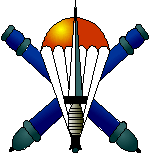
To reinforce and increase the fire power of the Para-Commando Regiment, it is decided in 1972 to create a Para-Commando field artillery unit.
On 14 May 1973, the Unit is created in Brasschaat on an experimental basis. It is made up of the personnel of the Mortar platoon 4"2 of the 1 Para, the 3 Para and the 2 Cdo.
Commandant PSC Commando L Henrot is appointed as commandant of the new Unit.
On April 1, 1974, it officially receives the status of Independent Corps.
The Battery is made up of 9 Officers, 24 Non-commissioned officers and 97 Volunteers and Militiamen.
It is organized so as to function as independent Unit and is equipped with six "Howitzer 105 mm" towed by diesel Unimog vans.
Regularly taking part in AMF manœuvres (Denmark, Italy, Greece, Turkey), the Battery takes part each year in the AMF artillery exercises.
Since 1995, the Battery is, such as the Para-Commando brigade, attached to the Multinational Division (MNDC).
From January 29 to February 09, 1993, the battery takes part in operation "SUNNY WINTER" in BRAZZAVILLE (Congo), with the 3rd Para Battalion and the Atk Co, in order to protect the evacuation of expatriates from ZAIRE.
In 1993 the Battery takes part in mission UNOSOM in SOMALIA with the 2nd Commando Battalion under the blue beret to the service of the UN.
In April 1994, within the Para-Commando Brigade, the Battery takes part in mission "SILVER BACK" in RWANDA, in order to ensure the withdrawal of the 2nd Commando Battalion involved in mission UNAMIR and the evacuation of foreigners.
In May 1997, the Battery takes part in operation "GREEN STREAM" in BRAZZAVILLE, CONGO, as 4th Co of the 2nd Battalion of Commandos.
Since 1998, the Battery is equipped with 105 LG1 MKII (GIAT). However, it keeps three "HOWITZER 105" U.S., to be able to fire honour salvos at events concerning the royal family (marriages, births, deaths, taking oath of King...).
The Battery is the only one of the Belgian Army to be equipped with towed pieces; their use is simpler and more economic.
In April 1999, a Detachment of the Battery accompanies the 2nd Battalion of Commandos in ALBANIA for operation "ALLIED HARBOUR", (escort and protection of convoys of KOSOVAN refugees from KUKES to MJEDA). Mid-July, it gets back to Belgium.
The 2nd part of the Battery departs to ALBANIA in reinforcement of the 3rd Regiment of Lancers Parachutists, and returns to Belgium in mid-August.
Since September 4, 1976, the Para-Commando Artillery Battery is sponsored by the municipality of Bornem.
Traditions.
The bilingual Battery has taken up the Commando traditions : green beret and insignia specific to the Battery and the same attributes on the dress as the 2 Cdo Bn.
The six artillery pieces carry some citations of the three Para-Commando Battalions: Normandy, Oldenburg, Italy, Walcheren, Chatkol, Imjin.
Since March 2, 2004, the Para-Commando Field Artillery Battery has amalgamated with the 2d Artillery Battalion (2A). It is now named Para-Commando Battery /2A. The personnel keeps its green beret and continues to jump.
The Battery also keeps the RACh emblem which it had received when it was Para –Commando Field Artillery Battery.
Quarters.
Since its creation, the Battery is based in BRASSCHAAT.
|
|
Corps commanders. |
|
|
|
|
|
|
Major PSC |
L. Henrot |
1973-1975 |
|
Major |
E. Van Den Broek |
1975-1979 |
|
Major PSC i.r. |
C. Buze |
1979-1981 |
|
Major PSC i.r. |
J-P. Roman |
1981-1983 |
|
Major PSC |
W. Vanstraelen |
1983-1986 |
|
Major |
L. Saelens |
1986-1990 |
|
Major PSC |
M. Compernol |
1990-1994 |
|
Major |
H. Koumans |
1994-1996 |
|
Major PSC |
M. Depauw |
1996-1998 |
|
Commandant |
L. Helsen |
1998-2000 |
|
Major |
H. Holsteyn |
2000-2003 |
|
Commandant |
E. Norga |
2003- |
|
|
Corps warrant officers. |
|
|
|
|
|
|
Chief warrant officer |
A. Vandermaelen |
1976-1986 |
|
Warrant officer-Major |
W. Ophalfvens |
1986-2003 |
|
Chief warrant officer |
M. Van Hassel |
2003- |
|
|
Corps corporals. |
|
|
|
|
|
|
Chief corporal |
G. Panier |
1995-1999 |
|
Chief corporal |
H. Claessens |
1999- |
-------------------------------------------------------------------------------------------------------------------------------
14th PARA COMMANDO Engineers Company (Para-Cdo Eng Co)

On October 14, 1991, the Chief of Staff of the Land Force decides to give the Para-Commando Regiment an Engineers Company.
The 14th Company (Dutch-speaking), based in Arolsen in FRG, is designated to fulfill this role and the first Non-commissioned officers begin their Para-Cdo training in Marche-les-Dames. On July 01, 1992, the 14th Para-Commando Engineers Company is officially created.
Strong of 9 Officers, 46 Non-commissioned officers and 128 Troopsmen, the Company is made up of:
- two platoons "combat engineers";
- a platoon "mine planters";
- a platoon "countermine;
- a platoon "MAT";
- and a Staff platoon. (with a section "combat swimmers" in the staff platoon).
From December 23, 1992 to December 14, 1993, the Company provides a platoon in reinforcement on a rota basis for operations "Restore Hope" and "UNOSOM" in Somalia.
In one year, the whole Company takes part in these armed humanitarian missions under the aegis of the U.N.
1993, operation "Sunny Winter" to protect the evacuation of expatriates from Kinshasa. A section is mobilised in reinforcement of the 3d Para Battalion and the Anti-tank Company in Brazzaville (Congo). The section remains there from January 30 to February 7.
Likewise, during operation "Silver Back" in Rwanda in April 94, the Company will provide a section in reinforcement in Djibouti from April 27 to May 5.
1999, as from April 17, in reinforcement of the 2d Battalion of Commandos, a part of the 14th Company takes part in the humanitarian operation of NATO in Albania, "Allied Harbour". At the end of July, it gets back to Belgium. The second part of the Company departs in mid-July in reinforcement of the 3d Lancers Parachutists, still in Albania, but it will make a stay in Kosovo before getting back to Belgium in mid-August.
Quarters.
In May and June 1992, the Company leaves Germany and settles in Belgium in Emblem near Lier. In April-May 1994, it settles in Heverlee (Leuven).
Traditions.
The 14th Para-Cdo Engineers Company has taken up the Commando traditions and wears the green beret with the insignia of the Para-Cdo Brigade. The Roman engineer helmet can be seen on the insignia. The dress is the same as that worn by the 2d Battalion of Commandos.
The motto of the 14th Para-Cdo Engineers company is "Via VI" (I open the way), and holds the emblem of the 14th Engineers Battalion. It is a "Pennant" bearing the citations "Antwerp, Yser, 1914-1918 Campaign".
Since 1994, the Company is sponsored by the municipality of Sint-Niklaas.
On September 3, 2003, the 14th Para-Commando Engineers Company is dissolved.
|
|
Corps commanders. |
|
|
|
|
|
|
Major |
B. Vercruyssen |
1992-1994 |
|
Major |
P. Van Goethem |
1994-1997 |
|
Major |
W. De Cauwer |
1997-2000 |
|
Major |
R. Wagemans |
2000-2003 |
|
|
Corps warrant officers. |
|
|
|
|
|
|
Warrant officer Chef |
D. Robbens |
1992-2000 |
|
Warrant officer Chef |
L. Pauwels |
2000-2003 |
|
|
Corps corporals. |
|
|
|
|
|
|
1st Chief corporal |
F. Willems |
1994-1997 |
|
1st Chief corporal |
F. Van Der Verren |
1997-2003 |
-------------------------------------------------------------------------------------------------------------------------------
35th PARA-COMMANDO Anti-aircraft artillery battery (35 Para-Cdo AA)
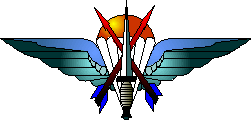
The 35th Anti-aircraft artillery battalion is created on June 1, 1951 and takes up the traditions of "Land Defence against Aircraft". In 1992, the Battalion is equipped with the weapon system "MISTRAL" (Missile Transportable Antiaérien Léger).
In 1994, the 35th Battalion is dissolved but a battery is maintained to become the 35th Para-Commando Anti-aircraft Artillery Battery.
On July 1, 1994, the new Unit is given a battle order: 8 Officers, 60 Non-commissioned officers and 90 Corporals and Soldiers, most of them coming from the 35 A, the 62 A and the ESR Company (Equipes Spéciales de Renseignements - Special Information Teams).
The Battery is created to function as an autonomous unit and is equipped with 18 MISTRAL firing stations.
The Battery enables a protection against aircraft at an altitude up to 2.000 meters. The optimal reach ranges between 800 and 5.000 meters.
1999, a Section, in reinforcement of the 2d Battalion of Commandos, takes part in Albania in NATO operation "Allied Harbour" and gets back to Belgium at mid-July. From July 15 to August 9, the Battery takes part in the same operation, in reinforcement of the 3d Lancers Parachutists Regiment. On September 2, 2002, within the framework of the reorganisation of the Army, the 35th Para-Commando Anti-aircraft Artillery Battery is dissolved.
Traditions.
The Battery (French-speaking, but part of the personnel is Dutch-speaking) has taken up the Commando traditions: green beret with the insignia of the Para-Commando Brigade, where two crossed (stylized) missiles can be seen, and the same attributes on the dress as the 2 Battalion of Commandos. By Royal Decree of July 30, 1994, the Battery has been entrusted with the Standard of the 35th Artillery Battalion. This Standard bears the mention: "Battle of Belgium 1940".
Since 1997, the Battery was twinned with the 35th Parachutist Battery (equipped with the same type of weapon) of the 54th Artillery Regiment of the French Army.
Quarters.
The Battery was based in the quarter "KNESSELAERE" in Spich, Germany.
|
|
Corps commanders. |
|
|
|
|
|
|
Major i.r. |
G. Vandeweyer |
1994-1996 |
|
Major i.r. |
J-L. Hiel |
1996-1998 |
|
Major |
D. Peeters |
1998-2000 |
|
Major |
P. Darvil |
2000-2002 |
|
|
Corps Warrant officers. |
|
|
|
|
|
|
Chief warrant officer |
L. Hillaert |
1994-1996 |
|
Chief warrant officer |
L.P. Bauwens |
1996-2002 |
|
|
Corps corporals. |
|
|
|
|
|
|
1st Chief Corporal |
J. Bosmans |
1994-1997 |
|
1st Chief Corporal |
F. Bouckaert |
1997-2000 |
|
1er Corporal-Chef |
S. Jeanmenne |
2000-2002 |
-------------------------------------------------------------------------------------------------------------------------------
210th PARA-COMMANDO Logistic Company (210 Para-Cdo Log Co).
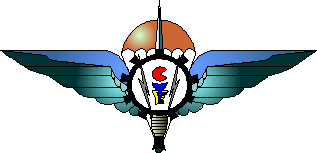
The 210th Logistic Company has been created on July 01, 1983 in Arolsen (FRG) as sub-unit of the 18th Logistic Battalion. This Unit was the result of the merging of the 210th Material Company and the 107th Supply and Transport Platoon.
In 1994, the Company settles in Heverlee (Leuven) and on September 30, it becomes the 210th Para-Commando Logistic Company.
On January 1, 1995, the Unit becomes an independent Corps and ensures the logistic support of the Para-Commando Brigade.
The Company is responsible for the supply and transport of the following products:
- Class I (food);
- Class II (equipment, armaments, material);
- Class III (fuels);
- Class V (ammunition) to the benefit of the units of the Para-Commando Brigade; it is also in charge of the maintenance of the Brigade vehicles.
Strong of 10 Officers, 73 Non-commissioned officers, 132 Troopsmen, the 210th Para-Commando Logistic Company is made up of:
- a Staff and Services cell;
- a supply and transport platoon with five sections;
- a technical platoon charged with the organisation of the work of the platoons;
- a supply platoon;
- a platoon maintenance of the vehicles;
- a platoon material;
- a supervision platoon;
- and a section NSE (National Support Element) when the Brigade or a Unit works in an international environment.
1999, as from April 17, half of the Company, in reinforcement of the 2d Battalion of Commandos, takes part in the humanitarian operation of NATO in Albania: "Allied Harbour". At the end of July, it gets back to Belgium. On July 9, the other half of the Company accompanies the 3d Lancers Parachutists Regiment in Albania to finish the operation "Allied Harbour" and remains there until mid-August.
In September 2003, it takes part in the creation of the 20 Logistic Battalion (20 Log Bn) and is then dissolved.
Traditions.
The Company (bilingual) has taken up the Commando traditions: the green beret with the insignia of the Para-Cdo Brigade and, superimposed, the symbols of Logistics.
The insignias on the uniform are the same as those of the units with Commando traditions.
Quarters.
Since 1994, the 210th Para-Commando Log Co is based in HEVERLEE (LEUVEN).
|
|
Corps commanders. |
|
|
|
|
|
|
Major |
P. Vandeput |
1994-1998 |
|
Major |
F. Cotton |
1998-2001 |
|
Major |
D. Laforce |
2001-2003 |
|
|
Corps warrant officers. |
|
|
|
|
|
|
Chief warrant officer |
F. Meulemans |
1994-1998 |
|
Warrant officer-Major |
A. Torremans |
1998-2003 |
|
|
Corps Corporals. |
|
|
|
|
|
|
1st Chief Corporal |
M. Meire |
1994-1997 |
|
1st Chief Corporal |
J. Davidovic |
1997-2002 |
|
1st Chief Corporal |
G. Denis |
2002-2003 |

